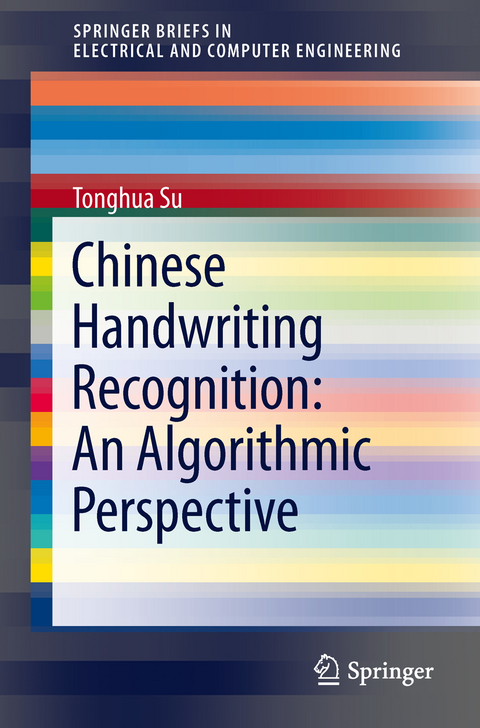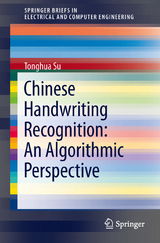Chinese Handwriting Recognition: An Algorithmic Perspective
Seiten
2013
|
2013
Springer Berlin (Verlag)
978-3-642-31811-5 (ISBN)
Springer Berlin (Verlag)
978-3-642-31811-5 (ISBN)
This book surveys algorithms used in Chinese handwriting recognition, covering celebrated methods and new scalable approaches, guidelines for sample collection, novel recognition paradigms, distributed discriminative learning, distributed estimation and more.
Designing machines that can read handwriting like human beings has been an ambitious goal for more than half a century, driving talented researchers to explore diverse approaches. Obstacles have often been encountered that at first appeared insurmountable but were indeed overcome before long. Yet some open issues remain to be solved. As an indispensable branch, Chinese handwriting recognition has been termed as one of the most difficult Pattern Recognition tasks. Chinese handwriting recognition poses its own unique challenges, such as huge variations in strokes, diversity of writing styles, and a large set of confusable categories. With ever-increasing training data, researchers have pursued elaborate algorithms to discern characters from different categories and compensate for the sample variations within the same category. As a result, Chinese handwriting recognition has evolved substantially and amazing achievements can be seen. This book introduces integral algorithms used in Chinese handwriting recognition and the applications of Chinese handwriting recogniers. The first part of the book covers both widespread canonical algorithms to a reliable recognizer and newly developed scalable methods in Chinese handwriting recognition. The recognition of Chinese handwritten text is presented systematically, including instructive guidelines for collecting samples, novel recognition paradigms, distributed discriminative learning of appearance models and distributed estimation of contextual models for large categories, in addition to celebrated methods, e.g. Gradient features, MQDF and HMMs. In the second part of this book, endeavors are made to create a friendlier human-machine interface through application of Chinese handwriting recognition. Four scenarios are exemplified: grid-assisted input, shortest moving input, handwritten micro-blog, and instant handwriting messenger. All the while, the book moves from basic to more complex approaches, also providing a list forfurther reading with literature comments.
Designing machines that can read handwriting like human beings has been an ambitious goal for more than half a century, driving talented researchers to explore diverse approaches. Obstacles have often been encountered that at first appeared insurmountable but were indeed overcome before long. Yet some open issues remain to be solved. As an indispensable branch, Chinese handwriting recognition has been termed as one of the most difficult Pattern Recognition tasks. Chinese handwriting recognition poses its own unique challenges, such as huge variations in strokes, diversity of writing styles, and a large set of confusable categories. With ever-increasing training data, researchers have pursued elaborate algorithms to discern characters from different categories and compensate for the sample variations within the same category. As a result, Chinese handwriting recognition has evolved substantially and amazing achievements can be seen. This book introduces integral algorithms used in Chinese handwriting recognition and the applications of Chinese handwriting recogniers. The first part of the book covers both widespread canonical algorithms to a reliable recognizer and newly developed scalable methods in Chinese handwriting recognition. The recognition of Chinese handwritten text is presented systematically, including instructive guidelines for collecting samples, novel recognition paradigms, distributed discriminative learning of appearance models and distributed estimation of contextual models for large categories, in addition to celebrated methods, e.g. Gradient features, MQDF and HMMs. In the second part of this book, endeavors are made to create a friendlier human-machine interface through application of Chinese handwriting recognition. Four scenarios are exemplified: grid-assisted input, shortest moving input, handwritten micro-blog, and instant handwriting messenger. All the while, the book moves from basic to more complex approaches, also providing a list forfurther reading with literature comments.
Dr. Tonghua Su has been working in the character recognition field over 10 years. The research group with which Dr. Su has been working released the HIT-MW database, which is now used at over 60 universities/institutes. They are the first group to systematically study the recognition problem of Chinese handwriting and developed the HMM-based recognizer and the PL-MQDF classifier for Chinese handwritten character recognition.
Introduction.- HIT-MW Database.- Integrated Segmentation-Recognition Strategy.- Segmentation-free Strategy: Basic Algorithms.- Segmentation-free Strategy: Advanced Algorithms
| Erscheint lt. Verlag | 11.1.2013 |
|---|---|
| Reihe/Serie | SpringerBriefs in Electrical and Computer Engineering |
| Zusatzinfo | XI, 124 p. 62 illus., 16 illus. in color. |
| Verlagsort | Berlin |
| Sprache | englisch |
| Maße | 155 x 235 mm |
| Gewicht | 220 g |
| Themenwelt | Informatik ► Grafik / Design ► Digitale Bildverarbeitung |
| Informatik ► Theorie / Studium ► Künstliche Intelligenz / Robotik | |
| Schlagworte | Chinese handwriting recognition • Chinesische Schriftzeichen • distributed training • machine learning • Mustererkennung • Optical Character Recognition • pattern recognition |
| ISBN-10 | 3-642-31811-8 / 3642318118 |
| ISBN-13 | 978-3-642-31811-5 / 9783642318115 |
| Zustand | Neuware |
| Haben Sie eine Frage zum Produkt? |
Mehr entdecken
aus dem Bereich
aus dem Bereich
Modelle für 3D-Druck und CNC entwerfen
Buch | Softcover (2022)
dpunkt (Verlag)
34,90 €
Methoden, Konzepte und Algorithmen in der Optotechnik, optischen …
Buch | Hardcover (2024)
Hanser (Verlag)
39,99 €




